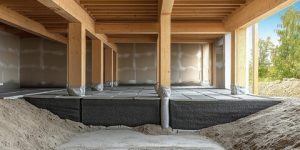Basement Remodeling Nashville TN focuses on creating a comfortable and inviting living space. It includes addressing structural issues like wet walls, sagging ceilings, and puddling water. It also includes adding plumbing and electrical components to support specialty rooms like a sauna or theater room.

Many homeowners choose to tackle some aspects of basement finishing themselves to cut labor costs. Basic tasks like painting and building non-load bearing walls are within their capabilities.
When planning the lighting in your basement remodel, it’s important to take into account the space’s intended use. The goal is to provide adequate light for each area of the basement while maintaining an open feel and minimizing dark spots. If your basement has windows, make sure to make the most of them. Strategically placed mirrors and neutral wall colors enhance and amplify natural light, which helps prevent the space from feeling too dark or closed off. Large egress windows can also help maximize daylight and improve safety while adding value to your home.
Recessed ceiling lights are an excellent choice for basements, as they eliminate shadows and glare. They can be installed in a variety of configurations and are especially well-suited for low ceilings. They also allow you to control the beam of light, so you can focus it on specific areas and create a focal point. If you’re not a fan of recessed lights, you can also try installing track lighting or directional spot fixtures to provide ambient light in your basement.
Another popular option is to install a decorative pendant or cove lighting in your basement. These fixtures add a pop of style to any room and are a great way to make a small space look larger. They are also flexible, so you can redirect the light when you change up your furniture or decorations.
Accent lighting, like wall sconces and track lighting, can add a soft glow to your basement while highlighting artwork, unique features, and other decorative elements. They can also brighten up a stairway and create a safe and welcoming entrance to your basement.
If your basement has a high ceiling, you can create the look of skylights using a technique called sun tubes. These are large-diameter tubes that extend from the roofline to the basement ceiling, allowing sunlight to fill your basement without the cost and maintenance of a real skylight.
Lighting is also a great way to create a cozy atmosphere for entertaining and relaxing in your basement. Consider adding a floor lamp or two to the space, if desired. They’re not as practical for a basement playroom or game room, as they can get knocked over by rambunctious kids, but they can be an excellent addition to a living area in the basement.
Egress windows
Egress windows are vital in a basement remodeling project for safety and compliance with building codes. These large window openings allow occupants to escape in the event of an emergency, such as a fire or flood. They also improve the quality of living in a basement bedroom by increasing natural light and enhancing the home’s overall livability.
In many older homes, there is a high likelihood that the basement area has narrow above-ground windows that are not large enough to exit through in an emergency. Fortunately, modern building codes prioritize safety and require egress windows for any basement rooms that are used as bedrooms.
Whether your basement is a finished or unfinished space, installing egress windows can transform it into a welcoming and comfortable environment. These windows are not only a legal requirement but will also increase the value of your property. In fact, potential buyers will look at your house with confidence if they know that your finished basement has a legal egress option.
There are several different types of egress windows, including casement, sliding (gliding), and double-hung. Each type has its own advantages and disadvantages. Casement windows are hinged at the side and swing open using a crank, making them easy to operate. However, they require a clear area outside to open fully. Sliding windows, on the other hand, slide horizontally along a track and provide half the opening space of a casement window.
Double-hung windows are more economical but do not offer as much opening space as casement windows. Both window styles are available in a wide range of sizes, so you can find the right fit for your basement.
It’s important to hire a professional contractor for any basement renovation, especially when installing egress windows. This ensures that the windows are installed according to code requirements and are waterproofed properly. It’s also crucial to consult with a structural engineer to determine if the windows will have any impact on the basement’s structure.
If you’re looking for a basement remodeling contractor, contact us today. Our professionals will “light the way” and help you create a beautiful, functional space that’s perfect for your family.
Ceiling height
The ceiling height in a basement remodeling project is one of the most important elements that you have to consider. This is because a low ceiling will make the space feel cramped and unwelcoming. Luckily, there are ways to improve the ceiling height and make the room feel much bigger.
You can use a number of different strategies to raise the ceiling in your basement. These include using paint, painting the walls with light hues to produce the appearance of reflection, and installing lighting fixtures. You can also install skylights to allow natural light to flood the basement.
If you want to create a modern and industrial look, you can use corrugated metal as your ceiling material. This can give your home a unique and distinctive style, and it is perfect for a basement renovation.
Another way to raise the ceiling height is by placing beams underneath your floor joists. This is a more complex and expensive solution, but it can give you the space you need. Before you proceed, you should hire a qualified contractor to inspect the existing foundation and ensure that it can support the new load. The contractor will also disconnect services like water, gas, and electricity and cut holes in the foundation to place jacks underneath it.
In addition to ensuring that the ceiling is the proper height, you should also be sure that it meets all building codes and regulations. According to the Ohio Residential Building Code, the minimum ceiling height for a habitable space is 6 feet 8 inches, except for furred areas under beams and girders. You should also consider the location and size of your ductwork, as this may affect how much headroom you can achieve.
A basement renovation can be a long process, so it is crucial to be patient and budget accordingly. Remember, you will have to pay for materials, hire contractors, apply for permits, and complete inspections. It is important to take the time and effort to ensure that your basement remodel is beautiful, functional, and a true extension of your house.
Layout
Before starting a basement remodeling project, it is important to consider how you will use the space. This will guide the layout and design of the new room. For example, you may want to turn the basement into a home theater or a kitchenette. In these cases, the design of the space must take into account the location of plumbing and electrical fixtures and the layout of cabinets and appliances. It is also crucial to consider whether or not you need a bathroom in the basement. Adding a bathroom can increase the cost of a remodel, so it’s important to consider this upfront.
Another important consideration is moisture issues in the basement. Moisture in the basement can lead to mold and mildew, which is costly to remediate. To avoid this, you should have your contractor evaluate the basement for moisture and make necessary repairs. They should also ensure that the basement is waterproof and insulated. It’s also a good idea to include a ventilation system in the basement. This will help to ensure a healthy, breathable environment and comply with local building codes.
You should also determine if the basement needs to be reframed or if the existing structure can be left intact. This will affect the final price of your remodel and will impact your budget. If you plan to convert the basement into a bedroom, it must be fitted with an egress window for safety reasons. Additionally, if you intend to turn the basement into a multipurpose area, it’s essential to have a clear layout that can adapt to changing needs over time.
Lastly, you should select a remodeling contractor that has experience working on basements. They will be able to understand the unique challenges that come with this type of construction and can help you create a functional space. They will also be able to provide you with a realistic timeline and budget for the project.
When hiring a basement remodeling contractor, choose one with experience and references. They should also be licensed and insured. They should also be familiar with local building codes and ordinances, which will ensure the renovation is up to code when it’s finished. Additionally, they should have the necessary skill sets to handle complex projects like adding a bathroom or plumbing.
